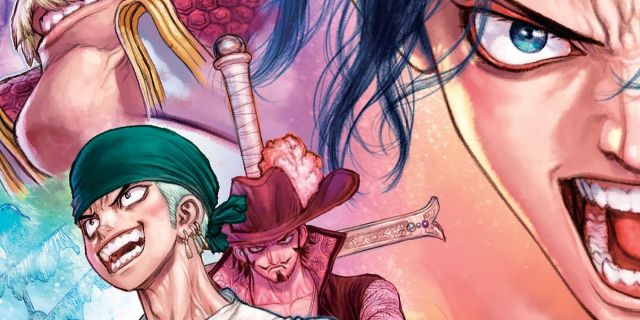Highlights
- Ace’s Story is a beautiful expansion of One Piece, combining Boichi’s art with a deeper look into Ace’s life and relationships.
- Boichi’s art style adds a grittier touch to the One Piece world, while still maintaining the humor and heart of Oda’s original work.
- The manga explores Ace’s origin story, focusing on his friendship with Masked Deuce and key moments in Ace’s life that fans will appreciate.
From time to time, major manga and anime franchises are expanded through the exploration of alternate stories or spin-offs which can help tie loose ends, grant additional context that may or may not have been important to the parent story, or simply to explore a completely new path for the franchise in question. Eiichiro Oda’s One Piece is the best-selling manga in history, with a huge world and massive cast of characters, each of whom is a person unto themselves.
However, the majority of fans developed a special love for the character of Portgas D. Ace, Luffy’s brother and biological son of the Pirate King, Gol D. Roger himself. In One Piece: Ace’s Story – The Manga, we get to follow Ace as a main character in a series that combines the brilliant artistic talents of Boichi, storyboards by Ryō Ishiyama with the world imagined by Oda. Here’s why it’s worth reading.
Incredible Art
Boichi Gives One Piece an Interesting Paint Job

Fans of the Dr. Stone series may already be familiar with the work of Boichi, a South Korean manga artist who has created a number of incredible original works, including the Sun-Ken Rock and Origin series, but is now known for his artistic contributions to the stories of other artists, including Eyeshield 21 author Riichiro Inagaki in the aforementioned sci-fi adventure. Now lending his pen to bring to life the storyboards created by fellow mangaka Ryō Ishiyama (Dragon and Chameleon), Boichi’s art in One Piece: Ace’s Story – The Manga fits the One Piece world in an interesting way, especially in contrast to the deliberately cartoonish and highly exaggerated art style explored by Oda in the parent story, Boichi’s art style exaggerates aspects of the characters and the world itself differently, reminiscent of stories that are a lot grittier or maybe graver in their approach to the plot and characters.
Despite its appearance of an exaggerated “seriousness”, Ace’s Story is great in how it doesn’t lose the fun or the humor that is endemic to One Piece and the way Oda has woven together a story that makes its audience experience a wide spectrum of emotions from humor to sadness and even joy. Those who get their hands on a physical copy of the first volume of Ace’s Story will be treated to a gut-wrenching full-color insert spread of Ace’s final moments tucked away in the cover, while the other side presents a jovial scene of Luffy with his first two crewmates, Zoro and Nami, again in Boichi’s style. These additions are a treat, especially for collectors and fans of One Piece and Boichi. The action flows beautifully and the immense detail that goes into Boichi’s art style for the series is a great fit, especially when it comes to combat and background art. To better illustrate the fact that the events within the manga are from the perspective of a book written about them, the various text boxes filled with narration were stylized to look like slightly worn pages from a diary, which is really nice touch and deepens the layers to the narration of the story.
What’s It About, Exactly?
A Manga Adaptation of Portgas D. Ace’s Origin Story

The manga takes us through the origins of Ace, beginning with his fated encounter with the aspiring writer Masked Deuce, whom he meets while marooned on an uninhabited island in East Blue. The story is from the perspective of a book written by Masked Deuce, the man who became Ace’s first-ever crewmate, as he writes to tell the true story of a man whom he says “lived like fire”. The first volume, illustrated by Boichi is an adaptation of the first volume of the two-part One Piece novel A, written by Shō Hinata. The first volume of Ace’s Story is titled “The Formation of the Spade Pirates”, and given that the cover image for the chapter is a monochromatic version of the spread depicting Ace’s last moments, readers of One Piece: Ace’s Story are expected to already know of Ace’s unfortunate death.
Ace’s relationship with Masked Deuce begins on a precarious island that the writer describes as the Antlion of the Sea due to its powerful currents that draws the unfortunate to its shores with no hope of ever escaping. Literally writing himself off as yet another victim, Masked Deuce abandons his project in light of his gnawing hunger. There’s nothing to eat on the island, and fishing is impossible. However, just as he looks back on his childhood dream of becoming a writer, Ace arrives wearing a smile on his face, scouting for a great patch of beach from which he could sail. Due to various circumstances, Masked Deuce finds himself having to work together with the peculiar stranger who doesn’t seem to fully recognize their situation, and it also explores the circumstances behind Ace eating the Mera Mera no Mi, the construction of Ace’s ship, the Striker, and various other major events in Ace’s life that didn’t get much focus in the parent story. For fans of One Piece, of Ace as a character, and of great art, One Piece: Ace’s Story – The Manga is definitely one to pick up.











Leave a Reply